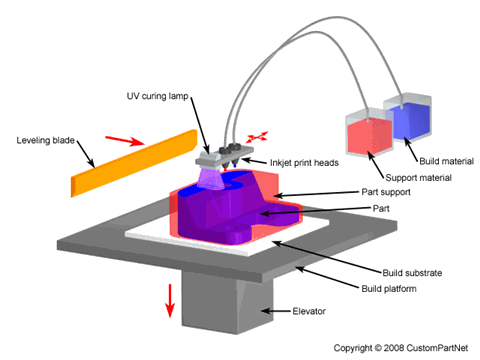- Processes
- Polymer Processing
- Blow Molding
- Injection Molding
- Metal Injection Molding
- Thermoforming
- Metal Casting
- Centrifugal Casting
- Die Casting
- Investment Casting
- Permanent Mold
- Sand Casting
- Shell Mold Casting
- Machining
- Milling
- Turning
- Hole-making
- Drill Size Chart
- Tap Size Chart
- Sheet Metal Fabrication
- Forming
- Cutting with shear
- Cutting without shear
- Gauge Size Chart
- Additive Fabrication
- SLA
- FDM
- SLS
- DMLS
- 3D Printing
- Inkjet Printing
- Jetted Photopolymer
- LOM
- Materials
- Metals
- Plastics
- Case Studies
- Cost Analysis
- Part Redesign
- Product Development
- Resources
- Curriculum Resources
- Glossary
Jetted photopolymer is an additive
process that combines the techniques used in Inkjet
Printing and Stereolithography. The method of building
each layer is similar to Inkjet Printing, in that it
uses an array of inkjet print heads to deposit tiny
drops of build material and support material to form
each layer of a part. However, as in Stereolithography,
the build material is a liquid acrylate-based photopolymer that is cured by a UV
lamp after each layer is deposited. For this reason,
Jetted Photopolymer is sometimes referred to as
Photopolymer Inkjet Printing. The advantages of this process are very good accuracy
and surface finishes. However, the feature detail and
material properties are not quite as good as
Stereolithography. As with Inkjet Printing, the most
common application of this technology is prototypes used
for form and fit testing. Other applications include
rapid tooling patterns, jewelry, and medical devices.
Two companies that have developed jetted photopolymer
devices include Objet Geometries Ltd. and 3D Systems.
The equipment designed by both companies deposits the
photopolymer build material as described above, but
differs in the application of support material. Objet,
an Israeli company, commercialized their PolyJet
technology in 2000. In the PolyJet system,
the support material is also a photopolymer that is
deposited from a second print head and cured by the UV
lamp. This support material does not cure the same as
the build material and can later be washed away with
pressurized water. 3D systems commercialized their
InVision systems in 2003. These jetted photopolymer
devices use a separate print head to deposit a wax
support material. After the part is completed, the wax
is melted away.
Capabilities
Disclaimer: All process specifications reflect the approximate range of a process's capabilities and should be viewed only as a guide. Actual capabilities are dependent upon the manufacturer, equipment, material, and part requirements.
Return to top |
